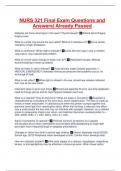NURS 321 Final Exam Questions and
Answers| Already Passed
Diabetes will show what signs in the eyes? Thyroid issues? ✅Retinal hemorrhages;
bulging eyes
What is a white ring around the eye called? What is it indicative of? ✅Arcus senilis;
indicative of high cholesterol
What is xanthoma? What might it indicate? ✅Looks like skin tags in eye on bottom
conjunctiva; may indicate lipid problem
What is normal vision change in those over 40? ✅Depressed myopia: difficulty
accommodating to close-up objects
What do halos in vision indicate? ✅Acute primary angle (closed) glaucoma-->
MEDICAL EMERGENCY (indicates innerocular pressure that suddenly occurs, no
exchange of fluid)
What is red reflex? ✅When light is shined in the eye, should see redness reflected
from eye as the eye reacts
Important steps in given eye drops ✅Should use separate R and L eye drop applicator;
need to change gloves and do hand hygiene between each eye
What is a cataract? How do they form? What are steps in formation? ✅Acataract is
characterized by a clouding of the eye's lens, which impairsvision. The lens is made up
mostly of water and protein. A cataractoccurs when this protein clumps together and
prevents some light form reachingthe retina. When first forming, a cataract may affect
only a small areaof the lens and may not interfere with eyesight. However, as a cataract
grows,in canseverely impair your vision, and treatment becomes necessaryolda); b =
safe_add(b, oldb); c = safe_add(c, oldc); d = safe_
Signs of symptoms of cataract? ✅Themost common symptoms of a cataract
are:cloudyor blurry vision seeinghalos around lights difficultyadjusting to bright light
poornight vision frequentchange in eyeglass prescriptions
Changes in vision from birth to school age children ✅Infants: hyperopic visual 20/200
School age: 20/20 Peripheral vision developed at birth; Central vision develops later
How are cataracts treated? ✅Inthe early stages of a cataract, eyeglasses, magnifying
lenses, or strongerlighting may be effective in improving vision. When these tactics
,fail,surgery is usually required. In cataract surgery, the lens of the eye isremoved and
replaced by an artificial lens. This new lens allows light to passthrough to the retina,
restoring vision. Cataract surgery is one of themost common surgeries preformed in the
United States. In fact, more than1 million procedures are performed each year, and
more than 95% of thesesurgeries are considered successful.:/QZ 8u[DuM5`;J~`u$0E
Who is at risk for a cataract? ✅Themost common type of cataract, age-related
cataract, affects more than half ofall Americans 65 years and older.
What is presbyopia? When is it common? ✅Difficulty accomodating; 70 years old
Vision changes in older adults ✅Presbyopia; visual disturbances with night vision,
smaller pupil, cataracts common; dry eye common
Important considerations for enhancing vision in older adults ✅Those >60 require 2
times more illumination for close tasks compared to the average 20 year old. Avoid
monochromic colors (blue, green, violet) because the older person will have difficulty
discriminating borders.
Eye Exam requires ✅Snellen Chart, Jaegar Card, Occulder, Penlight, Opthalmoscope
Entropian v. Ectropian ✅Entropian: lid goes in Ectropian: lid goes out
What do we assess lacrimal apparatus for? ✅Redness, swelling, and tenderness
What is the cornea? What do we evaluate? ✅Anterior outer layer that covers pupil and
iris Shine light from side; check smoothness, clarity, no breaks
What is the iris and pupil? How do we assess them? ✅Iris flat, round even color Note
pupil size, shape, equality
What is Brushfield spots? ✅White specks in the iris; sign of Down Syndrome
What is PERRLA? How do we test it? ✅Pupils Equal Round Reactive Light
Accommodation For Pupillary light reflex: darken room, patient looks straight ahead,
brng light to side, check direct and consensual response--document in mm. For
accomodation: constriction and convergence-- have patient look distant (pupils will
dilate), have patients look at object 3 inches from eyes (pupils will constrict with
closeness)
What are the 2Ds and 3Cs of accomodation? ✅2ds: distance-->dilate 3Cs: close,
converse, contrict
Normal pupillary size to light reflex ✅Usually 3-5 mm
, How is Snellen Chart used? What do results indicate? ✅Tests distance vision, stand
20 feet away, leave contacts and glasses, cover one eye, have pt read the smallest line
of print Normal=20/20 Numerator=distance from chart (should be 20) Denomintor=
distance normal eye could read chart
How is a Jaeger Card used? What are normal results? ✅Hold card 14 inches away,
test eyes individually with glasses; can test myopia and hyperopia Normal: 14/14 in
each eye
What is the confrontation test? What is normal? What should be documented?
✅0Measureof peripheral vision - practitioner's visual field MUST be
normal.0Advancingfrom periphery with finger, slightly behind patient0NORMAL= 50
degrees upward, 90 degrees temporal, 70 degrees down, 60 degrees
nasal.0DOCUMENT: Visual fields intact.
Extraocular muscle function involves testing what cranial nerves? ✅III, IV, VI
What is corneal light reflection test? What is normal result? What would documentation
be like? ✅Assess alignment of eyes, patient looks straight ahead, reflection of light on
corneas Normal is symmetric If abnormal then do cover/uncover test (when uncovering,
may see drifting of eye "lazy eye") Document: Corneal light reflex bilateral alignment
noted
What is the cover/uncover test for extraocular muscle function? What are normal
findings? ✅Patient looks straight ahead at distant object; cover one eye (look at
uncovered eye--> normal=fixed); uncover the eye--look at eye that was covered
(normal=eye should not move and should also be looking in the same direction); repeat
with other eye
What are cardinal positions of gaze? What is normal? What should you watch for?
✅Patient keeps head still and follow finger or penlight with eyes ONLY; move in 6
position--H position Normal-tracking with BOTH eyes Watch for: Lateral gaze,
nystagmus //fce-study.netdna-ssl.com/2/images/upload-
flashcards/64/67/97/18646797_m.jpg
Care of eyes includes: ✅0Clean frominner to outer canthus with wet, warm cloth,
cotton ball, or compress0Use artificialtear solution or normal saline every 4 hours if blink
reflex is absent - ifordered by physician00Care foreyeglasses, contact lens, or artificial
eye if indicated
How do blood vessels in eyes differ from the rest of vessels in body? ✅Veins are
larger in the eyes than arteries




